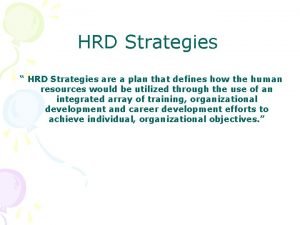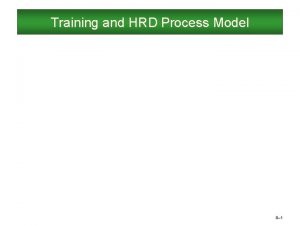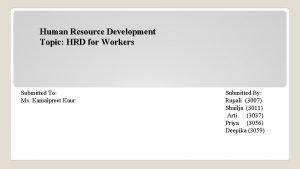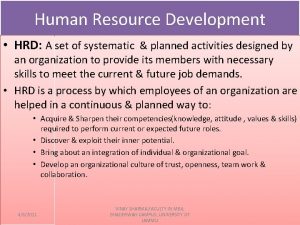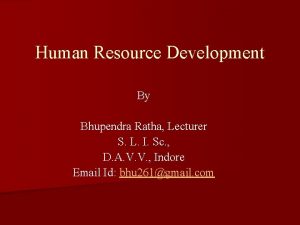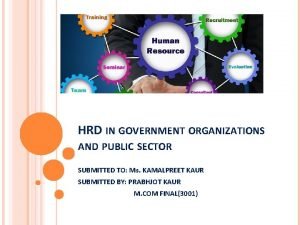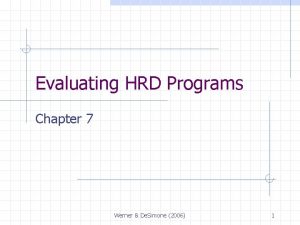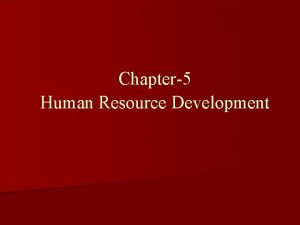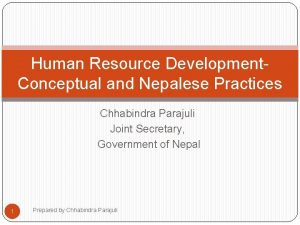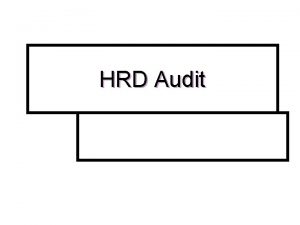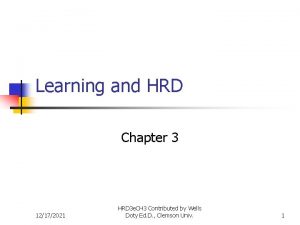HRD Strategy Towards 2030 Presentation Outline Introduction Outline




















- Slides: 20

HRD Strategy Towards 2030

Presentation Outline • • • Introduction Outline of the HRD Strategy of SA towards 2030 Underpinning approach & Assumptions Intervention Outcomes Role of Government Role of Social Partners Programme Priorities to address Key Imperatives Institutional Arrangements Accountability, Monitoring and Evaluation 2

Introduction • The Human Resource Development Strategy of South Africa (2010 – 2030) was approved by cabinet in 2010. • Central to the strategy (HRDSA) was the establishment of the Human Resource Development Council of SA (HRDC) launched in March 2010. • The HRD Strategy 2010 -2030 identified eight key objectives to be addressed in its first five years. • Since then government launched the NDP and the MTSF. • In view of new government plans and strategies, a review of the strategy became necessary. • Responding to the implications of the 4 th Industrial Revolution 3

Underpinning Approach Underpinning approach • Internationally HRD Councils are viewed as a unifying force and catalyst for performance excellence central to driving HRD change. • HRD Council is well placed to play this role, of guiding and shaping HRD, enabling dialogue and consensus building, identifying skills blockages and finding solutions. 4

Assumptions • HRD activities take place in a range of spaces and spheres • Needs to be foregrounded • Requires collective engagement within and across government and with other social partners • A supportive political environment. 5

Interventions • Monitor the extent to which HRD targets are being met. • Understand the blockages where targets are not being met. • Collectively agree on how the blockage (s) will be addressed (policy change? infrastructural change? Increased resources? and determine the roles and responsibilities of each of the players. • Monitor the extent to these interventions are being implemented and whether they are meeting the agreed upon targets. • Evaluate the impact of these changes so that there is increased data to support evidence based decision making. 6

Outcomes • Expanded access to quality education and training; • Increased access work integrated WIL opportunities; • An improvement in throughput, pass rates and learning outcomes • Graduates are able to access the workplace; • The system will produce more research and innovation • There will be a more effective education and training and skills development system • Digitalisation will become a key component of the strategy. 7

Role of Government • To have clearly defined roles in relation to the implementation • • of the Strategy. Government committed to ensuring that cross-departmental blockages can be discussed and plans to address these agreed upon. Departments will report on activities that fall within their responsibilities and that are important for the HRD Strategy The Provincial HRD Councils will support the alignment between the provincial plans and activities and the HRDCSA. Local government strategies and plans to be designed to take into account national imperatives whilst responding to local priorities and imperatives. 8

Role of Social Partners Role of Business • Continue to work on commitments within the Skills Accord • Implement the CEO Initiative to support a Youth Employment Scheme (YES) which aims to put one million youth into internships • Provide additional funding for bursaries as well as other skills priorities. • Continue supporting the employment tax incentive scheme; • Ensure worker education in relation to the training of negotiators in collective bargaining. • Become more active in SETAs including supporting the process of mapping the skills requirements per sector. 9

Role of Social Partners…. Cont. Role of Labour – Assisted by Government • Focus on worker education including the training of shop stewards and negotiators to improve their understanding of labour law; • Support an analysis of requirements (skills audit) and assist to identify programmes that will address the needs identified general education as well as technical skills. • Support training for the unemployed by supervising and mentoring learners in accordance with agreed upon ratios for the sector. 10

Role of Social Partners…. Cont. • Make resources available to support skills training as part of its commitment to job creation • Advocate for the adoption of ILO conventions to support workplace education and training. • Labour is committed to ensuring there is high level and appropriate representation on all key structures relating to HRD. 11

Role of Communities • Communities act as a direct mechanism for channelling HRD imperatives through participation in HRD Council structures. • Community involvement enables all citizens to meaningfully influence the decisions that affect their lives. • Provide vital information on community development issues. • Communities will be able to make decisions on the economic, social, environmental, political, psychological, and other impacts. 12

Programme priorities to address key imperatives Programme 1: Foundation Education with Science, Technology, Engineering, Maths and Languages and Life Orientation/Skills Programme 2: TVET and the Rest of the College System Programme 3: Higher Education and Training, Research and Innovation Programme 4: Skills for the transformed society and the economy Programme 5: Developmental/capable state 13

Programme Priorities: Programme 1 Foundation Education with Science, Technology, Engineering, Maths and Languages and Life Orientation/Skills • Progress: ECD has been expanded; increase in Grade R enrolments; improved equity in learning outcomes and increased learner achievement in physical science and maths. • Priorities: Achieve professional standards in teaching: Ensure sound governance and management in schools; and, expand the level and quality of school support that is provided by the Districts. 14

Programme Priorities: Programme 2 TVET and rest of the College System • Progress: Improvement in enrolment; the NSFAS has expanded the funding of students in the colleges and an improvement in the certification rates in both NCV and Nated programmes. • Priorities: Improve teaching capacity (particularly about industry); address standard of equipment in workshops; align curriculum with needs of industry; support access to work placements and address needs of employed workers through more flexible learning pathways. 15

Programme Priorities: Programme 3 Higher Education and Training, Research and Innovation • Progress: Increase in intermediate skills (artisans) and professionals produced; qualified engineers; improvements in the production of academics and industry-university partnerships in research and development. • Priorities: developing graduates in certain fields such as veterinary surgeons; availability of funding for higher education; expand number of black graduates (including the sciences); increased number of black academics and focus on the number of research publications and patents. 16

Programme Priorities: Programme 4 Skills for the transformed society and the economy • Progress: Increased number of qualified artisans; progress in worker education; ongoing work on occupational qualifications for priority occupations; expansion of the number of young people engaging in programmes; increased level of success in apprenticeships and learnerships and increased access to literacy programmes. • Priorities: increase quality and relevance of funded training especially in relation to SMMEs and emergent enterprises; increase number of participating employers; increased access to workplace experience and programmes resulting from RPL. 17

Programme Priorities: Programme 5 Developmental/capable state • Progress: Establishment of the National School of Government; whilst addressing the challenges of unemployed youth; through its extensive internship programme. • Priorities: Economic cluster departments need to have a stronger engagement in HRD efforts. Grow the work that is being undertaken by the school of government and the capacity of DPSA to drive the public sector HRD strategy. 18

Accountability, monitoring and evaluation • Monitoring and evaluation is key to the successful implementation of the HRD Strategy. • The principles underpinning the monitoring and evaluation of the HRD Strategy includes: Relevance, Accuracy, Currency, Accessibility, Results based, Responsibility: Accountability, Fairness, and Transparency. 19

THANK YOU!! 20
 Hrdsa
Hrdsa Hrd strategy
Hrd strategy Innovative finance
Innovative finance Project appraisal
Project appraisal Hrd process
Hrd process Assessing need for hrd
Assessing need for hrd Hrd program implementation
Hrd program implementation Defintion of hrm
Defintion of hrm Need of hrm
Need of hrm Hrd mechanism
Hrd mechanism Hrd subsystem
Hrd subsystem Dilip ratha
Dilip ratha Scope of hrd
Scope of hrd Rimal management
Rimal management Hrd in government sector
Hrd in government sector Purpose of hrd evaluation
Purpose of hrd evaluation Designing and developing effective hrd programs
Designing and developing effective hrd programs Functions of hrd
Functions of hrd Meaning of hrd
Meaning of hrd Hrm system in nepalese organization
Hrm system in nepalese organization Hrd delivery
Hrd delivery

